Related Research Articles
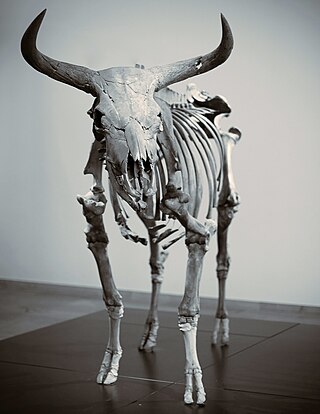
The aurochs is an extinct cattle species, considered to be the wild ancestor of modern domestic cattle. With a shoulder height of up to 180 cm (71 in) in bulls and 155 cm (61 in) in cows, it was one of the largest herbivores in the Holocene; it had massive elongated and broad horns that reached 80 cm (31 in) in length.

The zebu, sometimes known in the plural as indicine cattle or humped cattle, is a species or subspecies of domestic cattle originating in the Indian sub-continent. Zebu are characterised by a fatty hump on their shoulders, a large dewlap, and sometimes drooping ears. They are well adapted to withstanding high temperatures, and are farmed throughout the tropical countries, both as pure zebu and as hybrids with taurine cattle, the other main type of domestic cattle. Zebu are used as draught and riding animals, dairy cattle, and beef cattle, as well as for byproducts such as hides and dung for fuel and manure. Some small breeds such as the miniature zebu are also kept as pets. In 1999, researchers at Texas A&M University successfully cloned a zebu.

Bovines comprise a diverse group of 10 genera of medium to large-sized ungulates, including cattle, bison, African buffalo, water buffalos, and the four-horned and spiral-horned antelopes. The evolutionary relationship between the members of the group is still debated, and their classification into loose tribes rather than formal subgroups reflects this uncertainty. General characteristics include cloven hooves and usually at least one of the sexes of a species having true horns. The largest extant bovine is the gaur.

Bos is the genus of wild and domestic cattle. Bos is often divided into four subgenera: Bos, Bibos, Novibos, and Poephagus, but including these last three divisions within the genus Bos without including Bison in the genus is believed to be polyphyletic by many workers on the classification of the genus since the 1980s. The genus as traditionally defined has five extant species but this rises to eight when the domesticated varieties are counted as separate species, and ten when the closely related genus Bison is also included. Most but not all modern breeds of domesticated cattle are believed to have originated from the extinct aurochs. Many ancient breeds are thought to have originated from other species. Zebus and taurine cattle are thought to descend from ancient Indian and Middle Eastern aurochs, respectively.

Breeding back is a form of artificial selection by the deliberate selective breeding of domestic animals, in an attempt to achieve an animal breed with a phenotype that resembles a wild type ancestor, usually one that has gone extinct. Breeding back is not to be confused with dedomestication.

Heck cattle are a hardy breed of domestic cattle. These cattle are the result of an attempt by Heinz and Lutz Heck to breed back the extinct aurochs from modern aurochs-derived cattle in the 1920s and 1930s. Controversy revolves around methodology and success of the programme. There are considerable differences between Heck cattle and the aurochs in build, height, and body proportions. Furthermore, there are other cattle breeds which resemble their wild ancestors at least as much as Heck cattle.

The Oostvaardersplassen is a nature reserve in the Netherlands, managed by the Staatsbosbeheer. Covering about 56 square kilometres (22 sq mi) in the province of Flevoland, it is an experiment in rewilding. It is in a polder created in 1968; by 1989, its ecological interest had resulted in its being declared a Ramsar wetland. It became part of Nieuw Land National Park when that was established in 2018.
Tauros is a transliteration of either Ancient Greek: ταῦρος ('bull') or of Proto-Indo-European *táwros and may refer to:

Wildwood Discovery Park now known as the Wildwood Trust, is a woodland discovery park in Herne, near Canterbury Kent, England. It features over fifty species of native British animals such as deer, badgers, wild boar, wolves and brown bear. It is located on the main road A291 between Herne Bay and Canterbury.
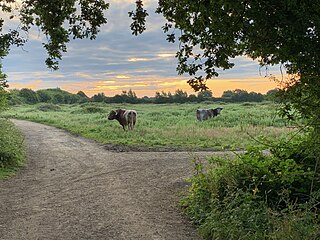
Rewilding, or re-wilding, activities are conservation efforts aimed at restoring and protecting natural processes and wilderness areas. Rewilding is a form of ecological restoration with an emphasis on recreating an area's "natural uncultivated state". This may require active human intervention to achieve. Approaches can include removing human artefacts such as dams or bridges, connecting wilderness areas, and protecting or reintroducing apex predators and keystone species.
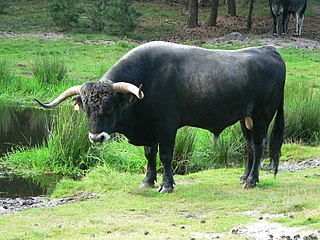
The Tudanca is a traditional Spanish breed of cattle from Cantabria, in northern Spain. It takes its name from the village of Tudanca in the Comarca de Saja-Nansa in western Cantabria. In the past it was a draught breed, much used for transport of goods to and from the ports of the Cantabrian coast; it is now reared for meat, but is still used in traditional sport of arrastre de piedra, or "stone-dragging". Despite its geographic proximity, it is not closely related to the other cattle breed of Cantabria, the Pasiega.
Pajuna is a rare Spanish cattle breed, originating in Granada (Andalusia), which resembles the extinct aurochs, the wild ancestor of domestic cattle, in certain features.
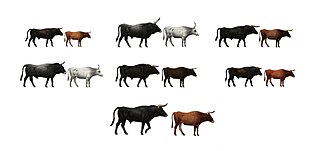
The Tauros Programme, formerly known as TaurOs Project, is a cooperation between the Dutch foundation Stichting Taurus and universities such as the Wageningen University and Research Centre. It is an international effort to breed a type of cattle that resembles the extinct aurochs, the wild ancestor of domestic cattle.
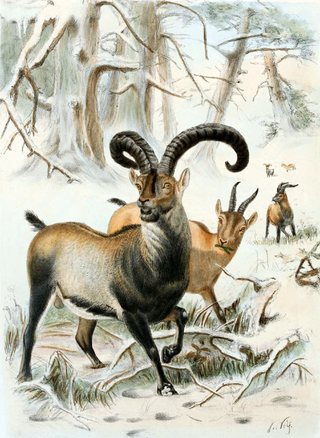
De-extinction is the process of generating an organism that either resembles or is an extinct species. There are several ways to carry out the process of de-extinction. Cloning is the most widely proposed method, although genome editing and selective breeding have also been considered. Similar techniques have been applied to certain endangered species, in hopes to boost their genetic diversity. The only method of the three that would provide an animal with the same genetic identity is cloning. There are benefits and malefits to the process of de-extinction ranging from technological advancements to ethical issues.

Lille Vildmose is a raised bog also known as the East Himmerland Moor in the hinterland in the municipalities of Aalborg and Mariagerfjord, Denmark. It is the largest remaining raised bog in Northwestern Europe. The bog is a remnant of heathland that once extended south from Limfjorden to Rold Forest.

The Taurus Project of the German Arbeitsgemeinschaft Biologischer Umweltschutz aims to re-create the extinct aurochs, the wild ancestor of domestic cattle, by cross-breeding Heck cattle with aurochs-like cattle, mostly from Southern Europe. Herds of these cross-bred Taurus cattle have been established in Germany, Denmark, Hungary and Latvia, and are used in conservation of natural landscapes and biodiversity.

The Uruz Project had the goal of breeding back the extinct aurochs. Uruz is the old Germanic word for aurochs. The Uruz Project was initiated in 2013 by the True Nature Foundation and presented at TEDx DeExtinction, a day-long conference organised by the Long Now Foundation with the support of TED and in partnership with National Geographic Society, to showcase the prospects of bringing extinct species back to life. The de-extinction movement itself is spearheaded by the Long Now Foundation.
Rewilding Europe is a non-profit organisation based in Nijmegen, Netherlands, working to create rewilded landscapes throughout Europe. Their goal is to maintain and expand areas of wildlife, in a manner that has a positive impact on climate and encourages biodiversity. The group's efforts have helped in increasing the stock of previously-endangered species such as the European bison and the Iberian lynx. Rewilding Europe was formally established on 28 June 2011 as an independent, non-for-profit foundation registered in the Netherlands. The four co-founders of Rewilding Europe are Frans Schepers, Staffan Widstrand, Neil Birnie and Wouter Helmer. Their set of projects have gradually expanded and they currently work on ten separate landscapes across 12 European countries including Germany, Italy, Romania, and Bulgaria. The organization has received funding from the European Investment Bank and the Endangered Landscapes Programme.

Milovice Nature Reserve is a nature reserve next to the towns of Milovice and Benátky nad Jizerou in Nymburk District, Central Bohemian Region, Czech Republic. Established in 2015, the area is administered by the Česká krajina o.p.s. organization, as a part of Evropsky významná lokalita Milovice-Mladá CZ0214006 protected area, part of the European Union project Natura 2000. This reserve is a pioneering project of cooperation between several scientific bodies and draws support from many organizations and private sponsors.
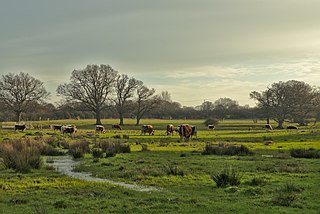
The wood-pasture hypothesis, also known as the Vera hypothesis and the megaherbivore theory is a scientific hypothesis that posits that open and semi-open pastures and wood-pastures formed and maintained by large wild herbivores, rather than primeval forests, would have formed the predominant type of landscape in post-glacial Europe, thus opposing the common belief. As the name Vera hypothesis implies, it was first proposed by Dutch researcher Frans Vera in his book Grazing Ecology and Forest History in 2000 and translated into English in 2002. Vera's ideas were not completely novel at the time. Already two years earlier, Oliver Rackham had published an article in which he criticised the idea of an all-encompassing, dark primeval forest in pre-Neolithic times as envisioned by the majority of scholars, however, Vera was the first to develop a comprehensive framework for such ideas and formulate a competing theorem. Vera's proposals, although highly controversial, came at a time when the role grazers played in woodlands was increasingly being reconsidered, and are credited for ushering a period of increased reassesment and interdisciplinary research in European conservation theory and practice. Although Vera largely focused his research on the European situation, his findings could also be applied to other temperate ecological regions worldwide, especially the broadleaved ones.
References
- ↑ "Algemeen || Stichting Taurus". Stichtingtaurus.nl. Archived from the original on 2012-09-11. Retrieved 2012-03-10.
- ↑ "Project TaurOs || Stichting Taurus". Stichtingtaurus.nl. Archived from the original on 2012-09-10. Retrieved 2012-03-10.
- ↑ Brabants Landschap: Het Taurus-rund op Keent. 2010.
- ↑ Stephan Faris, "Breeding Ancient Cattle Back from Extinction", TIME , February 12, 2010.
- ↑ Ben van Raaij: De Volkskrant: Oerrund blijkt superiour en wordt due teruggefokt. 2010.
- ↑ The Tauros Programme: “Tauros Organization.” Project website, without date. Retrieved 29 October 2017.
- ↑ The Tauros Programme: “The Tauros Programme.” Project website, without date. Retrieved 29 October 2017.